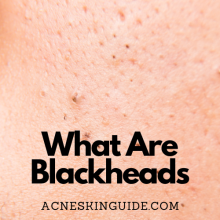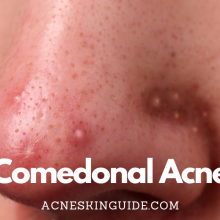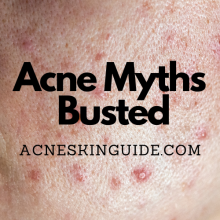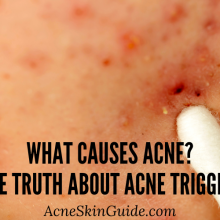Hormonal Acne – Causes, Symptoms, Treatments | AcneSkinGuide
Hormonal acne is a persistent form of acne directly linked to fluctuations and imbalances in hormones, primarily androgens. It is caused by factors such as puberty, menstrual cycles, PCOS, pregnancy, and menopause, leading to hormonal changes that stimulate excess oil production and clogged pores. Symptoms range from comedones to inflammatory lesions, often appearing on the lower face, jawline, and chin.
Treatment involves a multi-pronged approach targeting both the hormonal imbalance and visible acne lesions, including topical products, oral medications, hormonal therapies, and professional treatments like chemical peels or laser therapies. Lifestyle modifications, such as diet, stress management, and consistent skincare routines, can also support the management of hormonal acne, which can have a significant emotional impact and lead to scarring if left untreated.

Understanding Hormonal Acne: A Comprehensive Guide
Acne is a common skin condition that affects millions of people worldwide, and hormonal acne is a particularly stubborn and persistent form of this issue. Unlike other types of acne, which may be caused by factors such as excess oil production or bacteria, hormonal acne is directly linked to fluctuations and imbalances in hormones, primarily androgens like testosterone.
Causes of Hormonal Acne
Hormonal imbalances play a crucial role in the development of hormonal acne. Androgens, which are present in both men and women, can stimulate the sebaceous glands to produce excess sebum (oil), leading to clogged pores and breakouts. Several factors can contribute to hormonal imbalances and subsequent acne flare-ups:
- Puberty: During puberty, the surge in androgen levels can trigger hormonal acne, making it a common experience for many teenagers.
- Menstrual cycle: Fluctuating levels of hormones like estrogen and progesterone during the menstrual cycle can lead to premenstrual or menstrual acne in women.
- Polycystic Ovary Syndrome (PCOS): Women with PCOS often have higher levels of androgens, increasing their risk of developing hormonal acne.
- Pregnancy: Hormonal changes during pregnancy can also contribute to acne breakouts in some women.
- Menopause: Shifting hormone levels during menopause may cause hormonal acne in some women.
- Hormonal changes in men: While less common, hormonal fluctuations in men can also lead to acne breakouts.
In addition to hormonal factors, genetics, stress, and certain dietary choices (such as consuming high-glycemic foods or dairy products) may exacerbate hormonal acne in some individuals.
Symptoms and Types of Hormonal Acne
Hormonal acne often appears on the lower face, jawline, chin, and cheeks, although it can also occur on other areas of the body. The lesions can range from non-inflammatory comedones (blackheads and whiteheads) to inflammatory papules, pustules, and even painful cystic acne.
The presentation of hormonal acne can vary depending on an individual’s age and life stage. For example, teenagers may experience more widespread breakouts, while adult women might notice hormonal acne flare-ups around their menstrual cycles or during pregnancy.
In some cases, individuals may also experience a condition called acne inversa, which involves acne-like lesions in areas like the underarms, groin, or other skin folds.
Treatment Options for Hormonal Acne
Treating hormonal acne often requires a multi-pronged approach targeting both the hormonal imbalance and the visible acne lesions.
Topical treatments:
Over-the-counter topical products containing ingredients like retinoids, benzoyl peroxide, or salicylic acid can help unclog pores, reduce inflammation, and promote cell turnover. These may be effective for mild to moderate hormonal acne.
Oral medications:
For more severe cases, prescription oral medications may be recommended by a dermatologist. Birth control pills can help regulate hormones and reduce androgen levels in women, while medications like spironolactone (an anti-androgen) or isotretinoin (a potent vitamin A derivative) may be prescribed for stubborn or cystic hormonal acne.
Hormonal therapies:
Addressing the underlying hormonal imbalance is crucial for long-term management of hormonal acne. Birth control pills and anti-androgen medications can help regulate hormone levels and reduce acne breakouts.
Combination therapies:
Often, a combination of topical treatments, oral medications, and hormonal therapies is most effective for managing hormonal acne. This approach targets the condition from multiple angles and may be recommended by a dermatologist based on the individual’s specific needs.
Natural remedies:
Certain lifestyle changes and natural remedies can also support the treatment of hormonal acne. These may include dietary modifications (such as reducing intake of high-glycemic foods and dairy), taking supplements like zinc or omega-3 fatty acids, and practicing stress management techniques.
It’s important to have realistic expectations and understand that treating hormonal acne can be a gradual process. Some treatments may take several weeks or months to show noticeable improvements.
Professional Treatments
In cases of severe, persistent, or treatment-resistant hormonal acne, professional treatments may be recommended by a dermatologist. These can include:
- Chemical peels: Peels containing alpha-hydroxy acids or other active ingredients can help unclog pores and promote cell turnover.
- Laser and light therapies: Procedures like photodynamic therapy or intense pulsed light (IPL) can reduce inflammation and target acne-causing bacteria.
- Corticosteroid injections: For painful cystic acne lesions, steroid injections can provide relief and reduce inflammation.
Hormonal Acne in Different Skin Types
The presentation and management of hormonal acne may vary depending on an individual’s skin type. Those with oily skin may be more prone to inflammatory lesions, while those with dry or sensitive skin may experience different types of breakouts. Additionally, hormonal acne can present differently in different ethnic skin tones, and treatment approaches may need to be tailored accordingly.
Myths and Facts about Hormonal Acne
There are several myths and misconceptions surrounding hormonal acne that need to be addressed:
- Myth: Hormonal acne only affects teenagers. Fact: Hormonal acne can occur at any age, from puberty to adulthood and even during menopause.
- Myth: Certain foods directly cause hormonal acne. Fact: While diet may play a role in exacerbating acne for some individuals, there is no evidence that specific foods directly cause hormonal acne.
- Myth: Hormonal acne is solely a female issue. Fact: While more prevalent in women due to hormonal fluctuations, hormonal imbalances can also lead to acne in men.
Emotional Impact and Self-Care
Hormonal acne can have a significant emotional toll, affecting an individual’s self-esteem, confidence, and overall well-being. It’s important to prioritize self-care practices, such as stress management techniques (like meditation or exercise), seeking support from loved ones or support groups, and practicing self-compassion.
Acne Scarring
One of the potential downsides of hormonal acne, particularly severe or cystic lesions, is the risk of acne scarring. If left untreated or improperly managed, hormonal breakouts can lead to permanent scarring, including atrophic scars (depressed or pitted scars) or hyperpigmentation (darkening of the skin).
In cases where acne scarring has occurred, additional treatments like chemical peels, microneedling, or laser resurfacing may be recommended by a dermatologist to improve the appearance and texture of the skin.
Prevention and Management Tips
While hormonal acne can be challenging to control, there are several steps individuals can take to help prevent and manage flare-ups:
- Maintain a consistent skincare routine: Using gentle, non-comedogenic products and avoiding harsh scrubbing or picking at lesions can help minimize irritation and prevent further breakouts.
- Monitor hormonal changes: Being aware of hormonal fluctuations (such as menstrual cycles or stress levels) can help anticipate potential acne flare-ups and take proactive measures.
- Make lifestyle modifications: Adopting a balanced diet, staying hydrated, managing stress, and getting regular exercise can support overall hormonal balance and skin health.
When to See a Dermatologist
If over-the-counter treatments are ineffective, or if acne is severe, persistent, or causing significant emotional distress, it is recommended to seek professional help from a board-certified dermatologist. A dermatologist can thoroughly evaluate the individual’s condition, identify any underlying causes, and develop an appropriate treatment plan tailored to their specific needs.
Conclusion
Hormonal acne is a complex and often stubborn condition influenced by various internal and external factors. While it can be challenging to manage, a comprehensive approach that addresses the hormonal imbalance, utilizes targeted treatments, and incorporates lifestyle modifications can be effective in achieving long-term control. It’s crucial to have patience, persistence, and seek professional guidance when necessary to achieve optimal results and minimize the potential for scarring or emotional distress.
FAQs and Answers
Can hormonal birth control cause or worsen acne in some women?
Yes, hormonal birth control can potentially cause or worsen acne in some women. This is because different formulations of birth control pills contain varying types and amounts of hormones, primarily estrogen and progestin.
Some progestin types, particularly those derived from testosterone like norgestimate, norethindrone, and levonorgestrel, can have an androgenic (male hormone-like) effect in some women. This can lead to increased oil production and clogged pores, resulting in acne breakouts or a worsening of existing acne.
However, it’s important to note that not all women will experience this side effect, and many find that birth control pills actually help improve their acne. This is because birth control pills containing progestins with low androgenic activity, combined with estrogen, can help suppress ovarian androgen production and regulate hormonal fluctuations that contribute to acne.
If a woman experiences worsening acne after starting a particular birth control pill formulation, it may be necessary to switch to a different formulation with a different type or lower dose of progestin, or to consider alternative treatment options under the guidance of a dermatologist or gynecologist.
It’s also worth noting that during the first few months of starting any new hormonal birth control method, it’s common for some women to experience temporary acne flare-ups as their bodies adjust to the new hormone levels. However, if acne persists or worsens beyond the initial adjustment period, it may be a sign that the specific formulation is not suitable for that individual.
Can hormonal acne be mistaken for other skin conditions?
Yes, hormonal acne can sometimes be mistaken for other skin conditions that cause similar types of lesions or bumps. Here are a few examples:
- Rosacea
In some cases, the papules and pustules associated with hormonal acne, especially around the jawline and cheeks, can be confused with rosacea. Rosacea is a chronic inflammatory skin condition that causes redness, bumps, and visible blood vessels primarily on the face. - Folliculitis
Hormonal acne lesions that occur on areas like the chest, back or shoulders could potentially be misdiagnosed as folliculitis, which is an inflammation of the hair follicles often caused by bacterial or fungal infections. - Skin manifestations of PCOS
Women with polycystic ovary syndrome (PCOS) often experience hormonal imbalances that can lead to acne-like lesions. In some cases, the acne may be misattributed to other causes instead of being recognized as a symptom of the underlying PCOS. - Perioral dermatitis
This rash-like condition causes bumps and scaling around the mouth and nose area. Its appearance could potentially be confused with hormonal acne flaring up along the jawline. - Keratosis pilaris
The rough, bumpy texture of keratosis pilaris (“chicken skin”) on the upper arms or legs could be mistaken for acne lesions in some instances.
The key to proper diagnosis and treatment is a comprehensive evaluation by a board-certified dermatologist. They can examine the skin closely, review medical history and symptoms, and potentially order tests to differentiate hormonal acne from other lookalike conditions. Proper diagnosis ensures the most appropriate and effective treatment plan.
How does hormonal acne differ in appearance between men and women?
Hormonal acne can differ in appearance between men and women due to the differences in their hormonal profiles and patterns. Here are some key distinctions:
Location:
In women, hormonal acne often appears on the lower face, jawline, chin, and neck area. This is because these areas have a higher concentration of hormone-sensitive oil glands.
In men, hormonal acne is more likely to occur on the face, back, shoulders, and chest, which have more androgen receptor sites.
Lesion types:
Women with hormonal acne tend to experience more inflammatory lesions such as papules, pustules, and cystic acne.
Men with hormonal acne may have a higher incidence of non-inflammatory lesions like blackheads and whiteheads.
Severity:
Hormonal acne in women can sometimes be more severe and persistent due to the monthly fluctuations in hormones associated with the menstrual cycle.
In men, hormonal acne may be more consistent and less cyclical in nature.
Onset and duration:
For women, hormonal acne can begin during puberty, but may also occur or worsen during adulthood, especially during hormonal events like menstrual cycles, pregnancy, or menopause.
In men, hormonal acne often starts during puberty and may continue into adulthood, but is less likely to have cyclical flare-ups.
Factors like genetics, stress levels, and overall hormone balance can also influence the appearance and severity of hormonal acne in both men and women. However, understanding these general differences can help dermatologists tailor treatment approaches more effectively for each gender.
Can stress directly cause hormonal acne flare-ups?
Yes, it is true that gnats and other small flies are more attracted to certain colors than others. Research has shown gnats exhibit phototaxis – meaning their behaviors and movements are influenced by light wavelengths and colors.
Colors That Attract Gnats Most:
- Yellow
- White
- Blue
Gnats use their eyes to detect light in the ultraviolet range of the spectrum. The colors yellow, white, and blue reflect these UV wavelengths strongly, which lures in gnats.
This is why many commercial gnat traps feature bright yellow sticky surfaces – the gnats are naturally drawn to that color and get stuck to the trap when they land on it.
Colors That Repel or Don’t Attract Gnats:
- Red
- Black
- Green
- Purple
Darker shades like red, black, green and purple either absorb UV light or reflect wavelengths that gnats aren’t as sensitive to detecting.
Using this knowledge of color preferences can help control gnats. Yellow trap strips work well, while avoiding bright exterior lighting in white/blue hues could reduce attracting gnats inside at night. Some people have even had success using red mulches or covering plants with red filters to repel fungus gnats.
So in summary – yes, gnats definitely show a phototaxis behavior and are much more attracted to certain bright colors like yellows, whites and blues compared to other shades. Understanding these color biases provides effective means of monitoring and controlling gnat populations.
Are there any dietary supplements that have been shown to be effective for hormonal acne?
Gnat eggs and larvae have a very limited survival time without access to proper food sources and moisture levels. Their lifecycle is quite vulnerable if deprived of these essential conditions.
Gnat Eggs:
- Most gnat species’ eggs will only remain viable for 2-6 days maximum without the right humidity and materials to allow them to hatch properly.
- If the eggs dry out completely, they will not be able to hatch successfully at all.
Gnat Larvae:
- Newly hatched gnat larvae may survive for a few days without food by consuming nutrients from the egg casing.
- However, within about 4-5 days maximum, larvae require a constant source of organic matter to feed on continuously.
- Without damp, decaying plant matter, fungi, or other moist foods, the larvae quickly desiccate and die.
Overall Lifecycle Survival:
- From egg to adult, most gnat species require 14-30 days with adequate moisture and food sources present.
- If either humidity drops too low or food is removed at any larval stage, it prevents the gnats from completing their development cycle successfully.
- Some drought-resistant species can potentially extend the egg stage a bit longer before hatching when conditions improve.
So in summary, while adult gnats can live for several weeks, their eggs and larval stages have extremely limited survival – just several days maximum without moisture and food to sustain them through each lifecycle phase. Depriving them of these conditions is key to breaking the reproductive cycle and eliminating gnat infestations.






